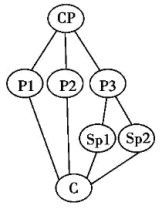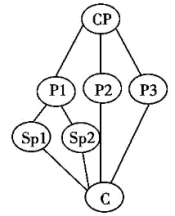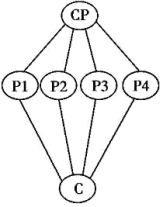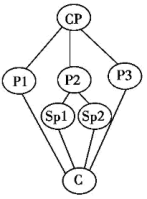1 . “After 30 years of reading cardiograms (心电图), I can never tell whether it’s from a man or woman, or the age of the person,” said Eric Topol, a cardiologist from Scripps Research in La Jolla, California. “A machine can detect if a person has anaemia (贫血) or other difficult diagnoses (诊断).”
Topol is excited not only about how machines are already better than experts at spotting problems, but how they can discover patterns that experts wouldn’t even notice. “In Japan, doctors are using machine vision to pick up polyps (息肉) in real time, and detecting whether or not they could be cancerous and whether they should have a biopsy,” he said. “Machines will not replace physicians—but physicians making use of AI will soon replace those not using it.”
Still, these are early days for the application of AI in healthcare. Pearse Keane, a consultant doctor at Moorrelds Eye Hospital, has been leading a collaboration between Moor fields and Google’s Deep Mind Health. In 2018, he famously published a proof-of-concept paper in Nature showing the erst successful AI diagnosis for eye disease. “The algorithm that we’ve developed isn’t in clinical use at the minute, so we’re trying to implement this now,” Keane said.
Keane mentioned the INSIGHT study, which is looking into eye disease and its link to other conditions such as diabetes (糖尿病). “We are using the eye as a window to the rest of the body. With deep learning, we can now look at a retinal (视网膜)photograph and say: ‘This is a woman, she’s 58 years old, she’s not a smoker or a diabetic, her BMI is around 25, and her blood pressure is around 150 over 85’. Now, to me, that’s staggering.” Keane said.
The INSIGHT study is analysing more than three million OCT scans from around 300,000 patients. “We now know, for every person having had a retinal scan here, who’s gone on to develop a heart attack or diabetes,” he said. “The reason why we’re excited is that we think that if we can get the appropriate data sets and learn them deeply, we can find much more in the back of the eye about the health of the rest of the body.”
“The application of AI for healthcare and medicine is about precision and accuracy, but that’s not all,” said Topol. The most important aspect is how AI can promote a stronger human connection between doctor and patient. “We see patients in single digit numbers of minutes. And that’s not enough, you need the gift of time, which AI can give back,” he said. “Next year this will be the standard,” he believes. “Rather than doctors being data clerks, they will be making eye contact with patients. There’s no algorithm for empathy. That’s a human characteristic that we have to develop and get back in the way it used to be.”
1. According to Topol, machines in healthcare ______.| A.can pick up polyps |
| B.will replace doctors |
| C.are already better than experts |
| D.can discover if a patient has diseases |
| A.evaluate the effects of AI in healthcare |
| B.introduce a patient’s personal information |
| C.explain how deep learning detects diseases |
| D.show the present outcome of AI’s application |
| A.AI has been the standard of some advanced hospitals. |
| B.AI can improve the relationship between doctors and patients. |
| C.With deep learning, the researchers can find the secrets of the eye. |
| D.Doctors will spend more time on face-to-face communication with patients. |
| A.The AI’s application on diagnosis. |
| B.Successful AI diagnosis for eye disease. |
| C.The great clinical progress in deep learning. |
| D.The impact of AI on promoting human connection. |
2 . Stare at a blank wall in any room, and you are unlikely to learn much more than the paint color. But a new technology can inconspicuously scan the same surface for shadows and reflections.
This tool could gather information from a partial view of a space. It can spy on activity from around a corner.
As people move around a room, their bodies block a portion of any available light to create delicate and indistinct “soft shadows” on walls.
Sharma and other researchers did the experiment by filming a wall in a room as its occupants moved around and averaging the frames over time.
| A.The technology is thought advanced. |
| B.These can’t be caught by the human eye. |
| C.They recorded various activities of the people in the room. |
| D.Brightly colored clothing can even cast a light reflected glow. |
| E.It also can monitor someone who avoids a camera’s line of sight. |
| F.The system is considered a unique and wonderful discovery by camera specialists. |
| G.Although this system can function in any room, it performs poorly in dim lighting. |
3 . Farmed fish should have the same legal protection as other farmed animals, according to an animal welfare group. The Conservative Animal Welfare Foundation, which has Carrie Johnson as a supporter, says fish deserve to be treated with the same care as cows, pigs, sheep and other livestock because they experience stress and pain.
The foundation is focusing on improving fish welfare during slaughter (屠宰) because that is where the biggest differences in protection lie.
Slaughterhouses for land animals are required to have a vet on site and must have closed-circuit television in all areas where animals are handled, stunned and killed, with footage stored for independent inspection. Such legal requirements do not apply to fish slaughter facilities, which are not subject to routine welfare inspections by public bodies.
The UK industry, which rears up to 80 million fish a year, has instead adopted voluntary codes of practice. A report by the foundation cites evidence of abuses of fish revealed last year by The Times. A stunning machine at the firm’s plant at Arnish on the Isle of Lewis failed to make them unconscious and workers used their fingers to tear the gills (鳃) and struggled to keep up with the volume of fish wriggling on the unit. Fish were thrown and kicked as they struggled on the ground in 2020 at Test Valley Trout Farming in Hampshire, which supplied the Ritz and Harrods. Fish considered unprofitable were dropped on the floor and left to die. The company said the treatment of the fish was unacceptable and it operated under “the best industry standards available”.
The foundation’s report refers to the findings of the government’s Farm Animal Welfare committee, which said in a 2014 opinion on fish welfare that “at least some species, including trout, have a sensory experience of pain” as well as “a degree of sense”.
Studies have shown that fish feel pain and change their behaviour to avoid it. In one study, goldfish were given an electric shock in an area of a tank where they received food. They avoided that area for three days before hunger overcame their fear.
The foundation report states that the UK government is failing aquatic animals dismally and calls for unannounced welfare inspections of fish slaughterhouses and says they should be required to install closed-circuit television, with footage reviewed by public bodies.
1. What can we provide for the farmed fish?| A.Comfortable place. | B.Less pain. |
| C.Enough food. | D.Gentle love. |
| A.concerned | B.puzzled |
| C.surprised | D.scared |
| A.To encourage people to treat fish kindly. |
| B.To reveal the evidence of abuses of fish. |
| C.To appeal for the improvement of fish welfare. |
| D.To explain how fish experience pain during slaughter. |
I’m no literary Luddite (反对新技术的人). I bought an iPad with my first paycheck from my first full-time job after graduating from college. But after two years of reading occasionally on the device, I gave it away to my brother. It just wasn’t the right reading experience for me.
Technology lovers choose e-readers over books because e-readers are more convenient. They’re right. It is objectively easier to carry a 7oz (盎司) tablet with thousands and thousands of books at your fingertips than it is to carry five books in your bag, which is exactly what I did on vacation.
But I don’t read for convenience. I read to learn more about the world and myself. I have made friends by seeing a book cover in a cafe and noticing that it was the same title that I was reading. I can trace my life by the books that have been my companions. When I open an old book and come across my previously scribbled notes — shaky ones when I’ve been reading on the subway, covered in sand if I read it at the beach, next to a train ticket if I was traveling — I am able to add an extra level of personal depth and experience to the story I am about to reread. It’s just not enough to simply consuming the story, which is what e-readers are great for.
When I read paper books, I hold onto them for long periods of time. I just purchased a new bookshelf specially for my “to be read” pile. Once in a while, I go through the process of deciding which books to donate, but usually the idea of parting with a book feels like giving away a part of my soul.
Physical books may not be the most efficient medium, but they are the most meaningful. So keep your Kindle, by all means. But I’ll be happy hoarding with my library.
1. Why did the author give his iPad to his brother?2. What can the author get when he sees his notes in an old book?
3. Please decide which part of the following statement is false, then underline it and explain why.
● The author loves physical books and he usually gives them away when he finishes reading them.
4. What is your favourite book? And why? (about 40 words)
One evening I was going back from a supermarket. As I approached my car, I noticed one person
6 . The biomedical world is flooded in data. We have a lot of genomic information from mouse to human, precious health measurements from clinical tests, and a large amount of so-called real-world data from insurance companies and drugstores. Using powerful computers, scientists have carefully researched it with some fine results, but it has become clear that we can learn much more with an assist from artificial intelligence. Over the next decade deep-learning neural networks will likely transform how we look for patterns in data and how research is conducted and applied to human health. This special report explores the future of this new transformation.
Right now the biggest assumptions are being placed in the field of drug discovery, and for good reason. The average cost of bringing a new drug to market nearly doubled between 2003 and 2013 to $2.6 billion, and because nine out of ten fail in the final two periods of clinical tests, most of the money goes to waste. Every large drug company is working with at least one AI-focused start-up to see if it can raise the return on investment.
Machine-learning algorithms (算法) can get through millions of chemical compounds, narrowing the choices for a particular drug target. Perhaps more exciting, AI systems — free by leading theories and biases — can identify entirely new targets by spotting tiny differences at the level of cells, genes or proteins between a healthy brain and one marked by Parkinson’s — differences that might avoid or even puzzle a human scientist.
That same sharp-eyed ability is also being used to explain medical scans. Some systems can already discover early signs of cancer that might be missed by a radiologist or see things that are simply beyond human capacity — such as evaluating cardiovascular (心血管) risk from a retinal scan. The Food and Drug Administration is approving imaging algorithms at a rapid click. Other AI applications lie a bit further down the road.
Will the inefficiencies of today’s electronic health records (EHRs) be solved by smart systems that prevent prescribing mistakes and provide early warnings of disease? Some of the world’s biggest tech giants are working on it.
Despite fears that machines will replace humans, most experts believe artificial and human intelligence will work cooperatively. The bigger concern is a shortage of people with both biomedical knowledge and algorithm proficiency. If this human problem can be solved, the key to creating successful AI applications may depend on the quality and quantity of what we provide them with. “We rely on three things,” says the CEO of one deep-learning start-up. “Data, data and more data.”
1. Why do large drug companies work with AI-focused start-up?| A.Because it is required by the government to do so. |
| B.Because it helps to explore new medicine with others. |
| C.Because it saves costs for drug companies to explore AI. |
| D.Because it’s used to check if the return on investment can be increased. |
| A.Positive. | B.Negative. | C.Neutral. | D.Unclear. |
| A.Why New Technology Will Change Our Life |
| B.How Artificial Intelligence Will Analyze Data |
| C.How Artificial Intelligence Will Replace Humans |
| D.How Artificial Intelligence Will Change Medicine |
CP: Central Point P: Point Sp: Sub-point (次要点) C: Conclusion
A. | B. |
C. | D. |
7 . How to Find Time to Read?
That everyone’s too busy these days is ordinary. But one specific complaint is made especially sadly:
What makes the problem worse is that the usual time-management techniques don’t seem efficient. The web’s full of articles offering tips on making time to read: “Give up TV” or “Carry a book with you at all times”
So what does work?Perhaps surprisingly, scheduling regular times for reading. You’d think this might fuel the efficiency mind-set, but in fact, Eberle notes, such usual behaviour helps us “step outside time’s flow” into “soul time”.
“Carry a book with you at all times” can actually work, too-providing you dip in often enough, so that reading becomes the default state from which you temporarily surface to take care of business, before dropping back down. On a really good day, it no longer feels as if you’re “making time to read,” but just reading, and making time for everything else.
| A.How do we make reading easy? |
| B.There’s never any time to read. |
| C.In fact, “becoming more efficient” is part of the problem. |
| D.No mind-set could be worse for losing yourself in a book. |
| E.Most people don't pay more attention to physical book reading. |
| F.You could limit distractions by reading only physical books, or on single-purpose e-readers. |
| G.But in my experience, using such methods to free up the odd 30 minutes doesn’t work. |
8 . Shortage of Primary Care Threatens Health Care System
Increasing health care bills, long emergency-room waits and the inability to find a primary care physician just scratch the surface of the problems that patients face daily.
Primary care should be the support of any health care system. Countries with appropriate primary care resources score highly when it comes to health outcomes and cost. The U.S. takes the opposite approach by emphasizing the specialist rather than the primary care physician.
A recent study analyzed the providers who treat Medicare beneficiaries. The surprising finding was that the average Medicate patient saw a total of seven doctors - two primary care physicians and five specialists - in a given year.
Contrary to popular belief, the more physicians taking care of you doesn't guarantee better care. Actually, increasing fragmentation of care results in a corresponding rise in cost and medical errors.
How did we take little care of primary care? The key is how doctors are paid. Most physicians are paid whenever they perform a medical service. The more a physician does, regardless of quality or outcome, the better he's reimbursed. Moreover, the amount a physician receives leans heavily toward medical or surgical procedures.
A specialist who performs a procedure in a 30-minute visit can be paid three times more than a primary care physician using that same 30 minutes to discuss a patient's disease. Combine this fact with annual government threats to randomly cut reimbursements, physicians are faced with no choice but to increase quantity to boost income.
Primary care physicians who refuse to compromise quality are either driven out of business or to cash-only practices, further contributing to the decline of primary care.
Medical students aren't blind to this action. They know how heavily the reimbursement is against primary care. The recent numbers show that since 1997, newly graduated U.S. medical students who choose primary care as a career have declined by 50%. This trend results in emergency rooms being overwhelmed with patients without regular doctors.
How do we fix this problem?
It starts with reforming the physician reimbursement system. Remove the pressure for primary care physicians to squeeze in more patients per hour, and reward them for optimally managing their diseases and practicing evidence-based medicine. Make primary care more attractive to medical students by forgiving student loans for those who choose primary care as a career and reconciling the marked difference between specialist and primary care physician salaries.
We’re at a point where primary care is needed more than ever. Within a few years, the first wave of the 76 million Baby Boomers will become eligible for Medicare. Patients older than 85, who need chronic care most, will rise by 50% this decade.
Who will be there to treat them?
1. The author’s chief concern about the current U.S. health care system is _________.| A.the ever-rising health care costs | B.the declining number of doctors |
| C.the inadequate training of physicians | D.the shrinking primary care resources |
| A.the more doctors taking care of a patient, the better |
| B.visiting doctors on a regular basis ensures good health |
| C.seeing more doctors may result in more diagnostic errors |
| D.the more costly the medicine, the more effective the cure. |
| A.make various deals with specialists | B.improve their expertise and service |
| C.see more patients at the expense of quality | D.increase their income by working overtime |
| A.Extend primary care to patients with chronic diseases. |
| B.Recruit more medical students by offering them loans. |
| C.Reduce the tuition of students who choose primary care as their major. |
| D.Bridge the salary gap between specialists and primary care physicians. |
9 . On Friday afternoon Class Seven had an Art lesson. It was their favourite lesson of the week. Everyone
When Trudy came into the classroom, Rob Mason said, “Look out, here comes Trouble!” All the kids
That day, they were going to paint animals. Again, Trudy knocked over the jam jar. Dirty water spread in a pool across the table and
“I hate Art,” Trudy thought as she went home on the bus, wishing never to go to school again.
As soon as she got home, Mum asked her to take a
Trudy knocked on the door and the door opened. There stood an old lady, so tall and elegant, like her house, which was full of
“My mum’s your home help. She won’t be able to come tomorrow. She’s got a cold.”
“I’m sorry to hear that. What she needs is my special cold
Keeping her arms pressed to her sides, Trudy stood
“Why?”
“I am the clumsiest person in our school! I know something will get broken when I’m
“I used to be clumsy too, a real ugly little duck,” Mrs. Willow smiled. “But I grew up to be a swan(白天鹅).”
“But I don't think I shall,” Trudy doubted. “I’ll just grow up to be an ugly
“Not if you do as I did. You have to keep telling yourself that inside, where it matters, you’re really a swan.”
“I’m a swan,” Trudy
Next morning Mum’s cold was much better. “If Mrs. Willow’s cold cure is a kind of
In the school playground some children stood looking up into the chestnut tree. Lisa was in tears.
“What’s the matter?” asked Trudy.
“It’s my kite,” Lisa said, wiping her eyes. “Rob let go and it’s got
“I’ll get it down for you,” Trudy said kindly.
“No, you’ll tear it!” Lisa looked
For a moment Trudy felt like her old
She jumped up and grabbed the lowest
“Thanks, Trudy.” Lisa showed it to the others. “Look, it’s all right!”
Trudy felt very, very proud and different. Smiling at everyone, she walked swan-like across the playground and into school, so tall and
| A.except | B.besides | C.including | D.behind |
| A.danced | B.sang | C.laughed | D.jumped |
| A.took | B.turned | C.rolled | D.tripped |
| A.drew | B.drowned | C.marked | D.colored |
| A.success | B.masterpiece | C.failure | D.disaster |
| A.gift | B.textbook | C.message | D.letter |
| A.delicate | B.ugly | C.cheap | D.messy |
| A.care | B.leave | C.concern | D.cure |
| A.straight | B.still | C.by | D.tall |
| A.around | B.apart | C.ahead | D.away |
| A.dragon | B.swan | C.tiger | D.duck |
| A.touched | B.cleaned | C.cleared | D.wiped |
| A.imagination | B.magic | C.cheating | D.creation |
| A.stuck | B.crashed | C.torn | D.damped |
| A.satisfied | B.disappointed | C.frightened | D.delighted |
| A.beautiful | B.clumsy | C.dishonest | D.smart |
| A.root | B.trunk | C.branch | D.leaf |
| A.fly | B.design | C.make | D.free |
| A.carefully | B.doubtfully | C.confidently | D.anxiously |
| A.eager | B.elegant | C.enthusiastic | D.energetic |
10 . A Diet Without Enough Protein Can Cause Depression
Depression is a condition so common, the World Health Organization (WHO) calls it “a leading cause of disability.”
Difficulty in falling asleep, loss of appetite, and loss of ability to concentrate are just a few of the other effects of depression. WHO estimates that worldwide, at any one time, 350 million people suffer from the condition. While life events such as the loss of a spouse or a job may create a happening of depression, many cases come from within and are not caused by a life event.
Now scientists are working on a new aspect of cure: nutrition.
So what does protein have to do with all this? It all comes down to amino acids (氨基酸). Proteins are made up of amino acids, chemicals known as the “building blocks of life.” There are 20 different amino acids.
Both the human brain and nervous system use amino acids as a substance that creates a signal from one brain cell to another or one nerve cell to another, thus relaying information between the cells. What the final result then?
Since amino acids make up protein, a diet which lacks in protein will cause weaker communication between the brain cells. This lessens the signal being sent from one brain cell to the next during a thought.
| A.The ultimate effect is how we think. |
| B.Don't ruin your appetite by eating between meals. |
| C.Skipping meals itself can create a depressed mood. |
| D.A new research suggests that nutrition can lessen some of the risks of depression. |
| E.India is perhaps the world’s leader in researching the connection between diet and depression. |
| F.Many of them are made by the human body, but nine others, the “essential” amino acids, must be eaten in one’s diet. |
| G.The process can lead to twisted signals, which can not only lead to depression, but also, according to many scientists, aggression. |



